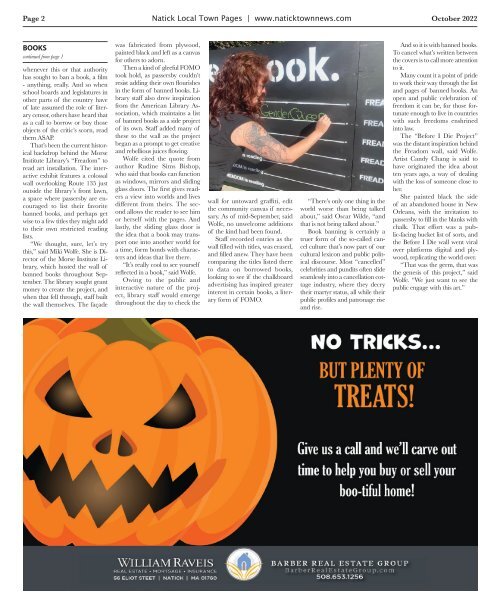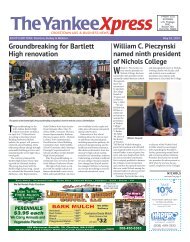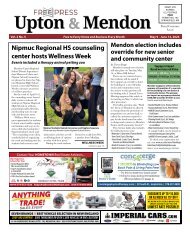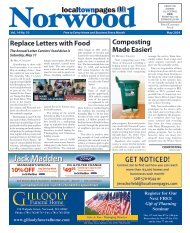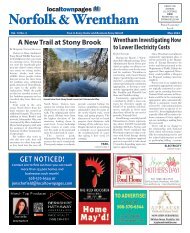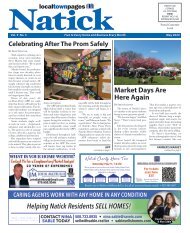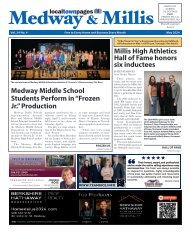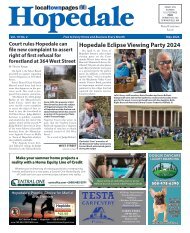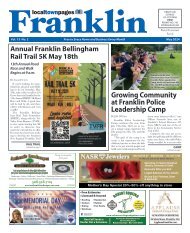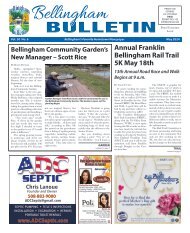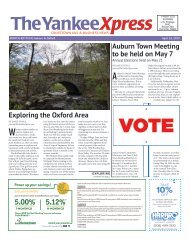Create successful ePaper yourself
Turn your PDF publications into a flip-book with our unique Google optimized e-Paper software.
Page 2 <strong>Natick</strong> Local Town Pages | www.naticktownnews.com <strong>October</strong> <strong>2022</strong><br />
BOOKS<br />
continued from page 1<br />
whenever this or that authority<br />
has sought to ban a book, a film<br />
- anything, really. And so when<br />
school boards and legislatures in<br />
other parts of the country have<br />
of late assumed the role of literary<br />
censor, others have heard that<br />
as a call to borrow or buy those<br />
objects of the critic’s scorn, read<br />
them ASAP.<br />
That’s been the current historical<br />
backdrop behind the Morse<br />
Institute Library’s “Freadom” to<br />
read art installation. The interactive<br />
exhibit features a colossal<br />
wall overlooking Route 135 just<br />
outside the library’s front lawn,<br />
a space where passersby are encouraged<br />
to list their favorite<br />
banned books, and perhaps get<br />
wise to a few titles they might add<br />
to their own restricted reading<br />
lists.<br />
“We thought, sure, let’s try<br />
this,” said Miki Wolfe. She is Director<br />
of the Morse Institute Library,<br />
which hosted the wall of<br />
banned books throughout September.<br />
The library sought grant<br />
money to create the project, and<br />
when that fell through, staff built<br />
the wall themselves. The façade<br />
was fabricated from plywood,<br />
painted black and left as a canvas<br />
for others to adorn.<br />
Then a kind of gleeful FOMO<br />
took hold, as passersby couldn’t<br />
resist adding their own flourishes<br />
in the form of banned books. Library<br />
staff also drew inspiration<br />
from the American Library Association,<br />
which maintains a list<br />
of banned books as a side project<br />
of its own. Staff added many of<br />
these to the wall as the project<br />
began as a prompt to get creative<br />
and rebellious juices flowing.<br />
Wolfe cited the quote from<br />
author Rudine Sims Bishop,<br />
who said that books can function<br />
as windows, mirrors and sliding<br />
glass doors. The first gives readers<br />
a view into worlds and lives<br />
different from theirs. The second<br />
allows the reader to see him<br />
or herself with the pages. And<br />
lastly, the sliding glass door is<br />
the idea that a book may transport<br />
one into another world for<br />
a time, form bonds with characters<br />
and ideas that live there.<br />
“It’s really cool to see yourself<br />
reflected in a book,” said Wolfe.<br />
Owing to the public and<br />
interactive nature of the project,<br />
library staff would emerge<br />
throughout the day to check the<br />
wall for untoward graffiti, edit<br />
the community canvas if necessary.<br />
As of mid-September, said<br />
Wolfe, no unwelcome additions<br />
of the kind had been found.<br />
Staff recorded entries as the<br />
wall filled with titles, was erased,<br />
and filled anew. They have been<br />
comparing the titles listed there<br />
to data on borrowed books,<br />
looking to see if the chalkboard<br />
advertising has inspired greater<br />
interest in certain books, a literary<br />
form of FOMO.<br />
“There’s only one thing in the<br />
world worse than being talked<br />
about,” said Oscar Wilde, “and<br />
that is not being talked about.”<br />
Book banning is certainly a<br />
truer form of the so-called cancel<br />
culture that’s now part of our<br />
cultural lexicon and public political<br />
discourse. Most “cancelled”<br />
celebrities and pundits often slide<br />
seamlessly into a cancellation cottage<br />
industry, where they decry<br />
their martyr status, all while their<br />
public profiles and patronage rise<br />
and rise.<br />
And so it is with banned books.<br />
To cancel what’s written between<br />
the covers is to call more attention<br />
to it.<br />
Many count it a point of pride<br />
to work their way through the list<br />
and pages of banned books. An<br />
open and public celebration of<br />
freedom it can be, for those fortunate<br />
enough to live in countries<br />
with such freedoms enshrined<br />
into law.<br />
The “Before I Die Project”<br />
was the distant inspiration behind<br />
the Freadom wall, said Wolfe.<br />
Artist Candy Chang is said to<br />
have originated the idea about<br />
ten years ago, a way of dealing<br />
with the loss of someone close to<br />
her.<br />
She painted black the side<br />
of an abandoned house in New<br />
Orleans, with the invitation to<br />
passersby to fill in the blanks with<br />
chalk. That effort was a public-facing<br />
bucket list of sorts, and<br />
the Before I Die wall went viral<br />
over platforms digital and plywood,<br />
replicating the world over.<br />
“That was the germ, that was<br />
the genesis of this project,” said<br />
Wolfe. “We just want to see the<br />
public engage with this art.”


